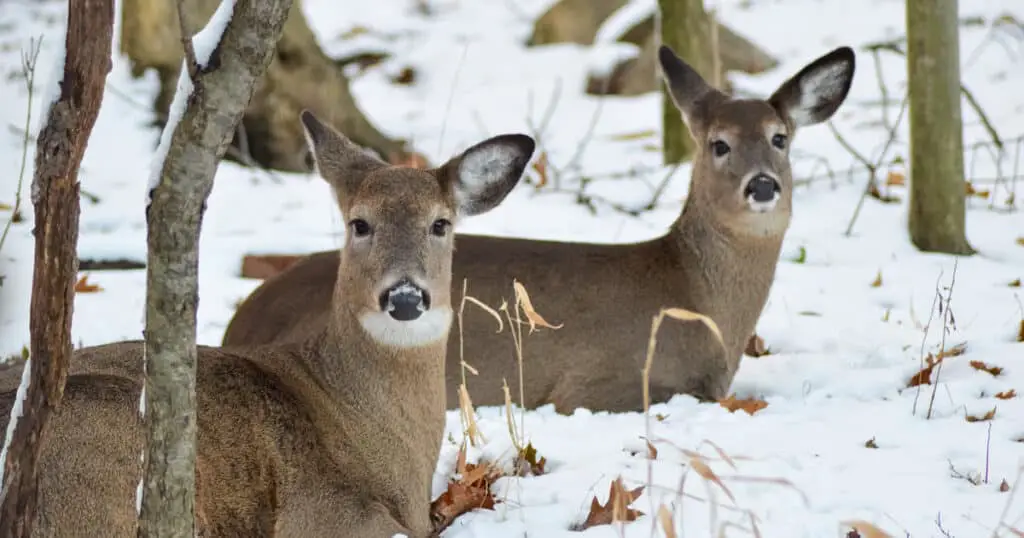Deer, like any other animal, like to have a cozy and warm place when they sleep. Deer live all over the world, and as such they inhabit drastically different climates, so it wouldn’t be right to say that all deer sleep in exactly the same way. However, there are some common features that deer look for in a bedding area, the most important being protection. Where do deer sleep in the winter, at night, and what makes a good area for deer to bed down?
We’ll explore all these topics and more in this article.
Deer Bedding Habits in Winter (in brief)
In winter, most deer choose to sleep on south-facing slopes, in areas with adequate browse nearby, good cover from the wind, but adequate sight-lines to allow them to see predators coming and allow adequate time to escape. The primary considerations for deer when choosing a bedding site in winter are:
- protection,
- adequate cover, and
- sufficient food
South-facing slopes provide warmer bedding locations with more sunlight during the day, which is why they are favored.
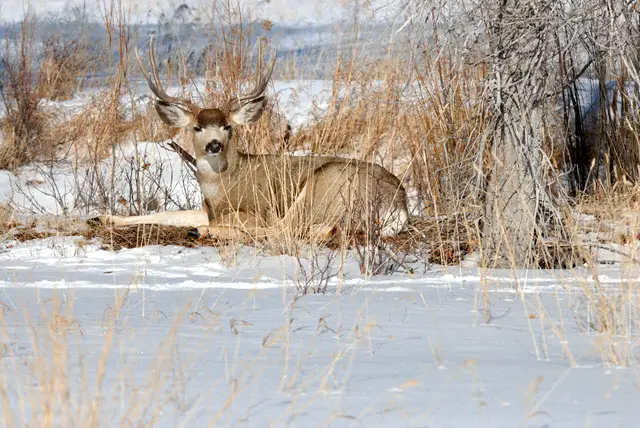
Where do Deer Bed Down at Night?
Deer tend to be creatures of habit. Once they’ve found a place they like to sleep, they will often return to the same place, though often they will have different locations for each season.
Like humans, they like to find places that are comfortable and warm. Deer tend to search for places that are protected from cold winds and will position their heads in a way as to keep that part of their body as warm as possible. South-facing slopes are preferred as they offer the maximum warmth from the sun.
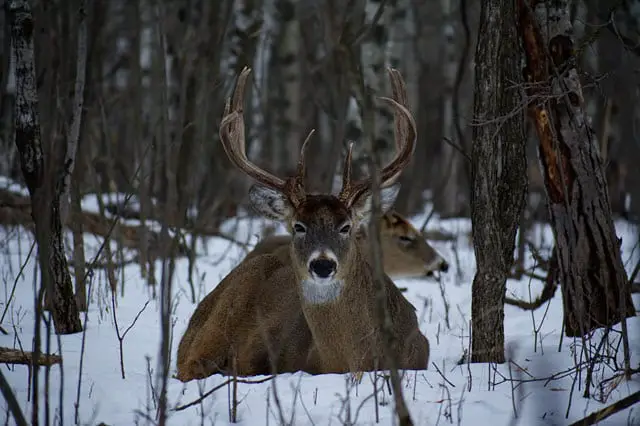
There are also many different types of deer, so sleeping habits vary quite a bit from species to species, and depending on the time of year, bedding habits can change significantly from summer to winter.
Do Deer Actually Sleep?
Yes, but not like humans. Where humans will sleep for hours at a time and go through phases of deeper and lighter sleep, deer never enter a state of deep sleep, and some deer will only ever actually sleep for thirty seconds at a time.
Deer always need to be on alert for predators, so they have to sleep lightly in case they need to escape quickly.
When Do Deer Sleep?
Deer are not nocturnal animals, they’re crepuscular – but they do not sleep at night as often as they do during the day.
That said, deer have one of the most unpredictable sleeping schedules of any animal in the wild. Often, their sleeping periods will only last about thirty to forty-five minutes, and during this time they only actually sleep in short intervals.
Their sleep schedules are frequently interrupted by perceived threats or simply the need to get up and stretch.
Do Deer Sleep Together or Alone?
This depends on the type of deer and can vary depending on the time of year.
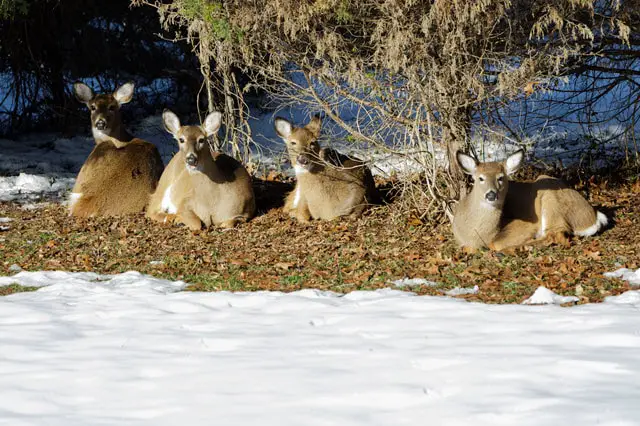
Sometimes deer prefer to sleep alone, and some species of deer such as moose are known for living mostly in solitude, whereas other species such as elk like to gather in large herds.
However, most deer live in herds and will sleep relatively close to their herd. Throughout most of the year, herds are divided by gender, though during the rutting and mating seasons, this can change.
Some mother deer will also sleep close to their young once they reach a certain age to protect them and keep them warm.
How to Spot a Deer’s Sleeping Area
These can be hard to find, and you have to know what you’re looking for. If a deer is sleeping in the same spot every night, the traces of the deer will start to show in the ground and you’ll be able to recognize a bedding area in the ground about the size of a deer when it’s laying down.
You’ll also notice lots of deer scat in the area.
Keep in mind that bucks and does are different sizes, so a buck bedding area will be larger than a doe bedding area.
What Does a Deer Look for in a Sleeping Area?
Protection, coverage and food are the main things that deer look for when selecting a sleeping area.
Protection comes in many forms and is the most important factor. Deer will often look for areas that protect them from wind, but camouflage is also an important factor when it comes to survival, so areas in or near forests are useful.
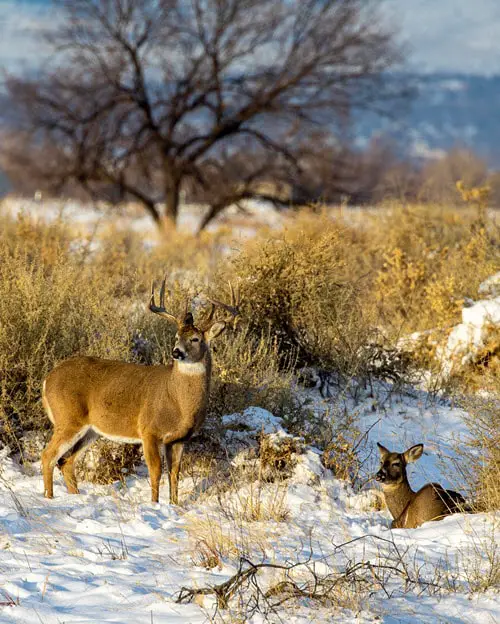
Easy access to food is also important, and deer tend to be browsers instead of grazers, meaning they are more likely to browse for food such as leaves or shoots instead of grazing in the field for grass.
In addition to food, deer need a reliable source of water, so they will often have bedding areas close to streams, rivers, or lakes.
Considering the deer’s main predators can be extremely fast, easy and fast exits are another important factor for deer. If a wolf sneaks up on them, they need to be able to get out as fast as they can, so a narrow valley or meadow with a single entrance and exit is not an ideal sleeping spot for deer.
How Do Deer Stay Warm in the Winter?
Though some deer (like Reindeer) live in more extreme areas such as the far North or South, where winters are much colder and characterized by heavy snowfall, all deer will eat more in the fall months so that they can increase their body fat for winter.
Unlike other animals such as bears, deer do not hibernate during the winter and remain active throughout the season. Later, during the rut, when male deer compete for females in the upcoming mating season, male deer lose most of this weight before preparing to gain it back again the following fall.
Deer coats also vary depending on the season. During the summer, the deer’s coat is significantly lighter than in winter, especially in areas with extreme weather.
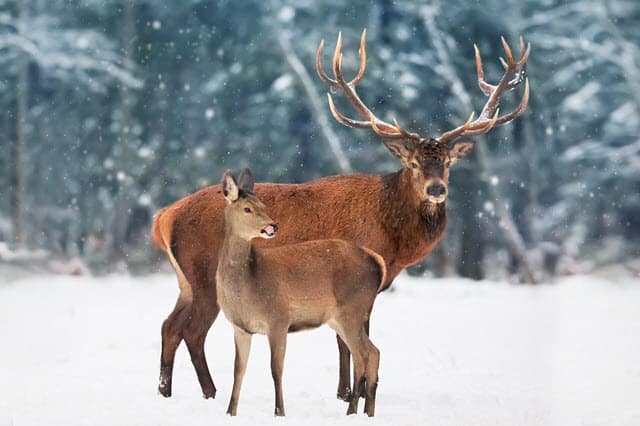
Generally speaking, deer follow a pattern that the farther north you go, the bigger deer you will find. So, if you’re hunting in Canada, you’re more likely to find bigger deer than in a warmer climate like Texas.
Another good trick deer have is changing their metabolism. You may think that winter means your metabolism needs to work faster, but a deer’s metabolism actually slows down in winter, allowing it to save energy.
Preferred Winter Habitat of Deer
Generally, deer prefer habitats that offer protection. They will try to find the spot that offers the most protection. In areas with heavy snowfall, this can actually be in the snow itself. Animals such as moose and elk will live in heavy snow because it provides protection from predators such as wolves.
In addition to protection from wolves, nestling down in the snow offers wind cover. During winter is when deer most often search for south-facing slopes for maximum sunlight, and light reflecting from the snow can act as an extra source of warmth.
Do Deer Live Close to Humans?
Yes, compared to other animals, deer live in relatively close contact to humans.
They often live in areas that border neighborhoods and are known to wander into backyards and even sleep there.
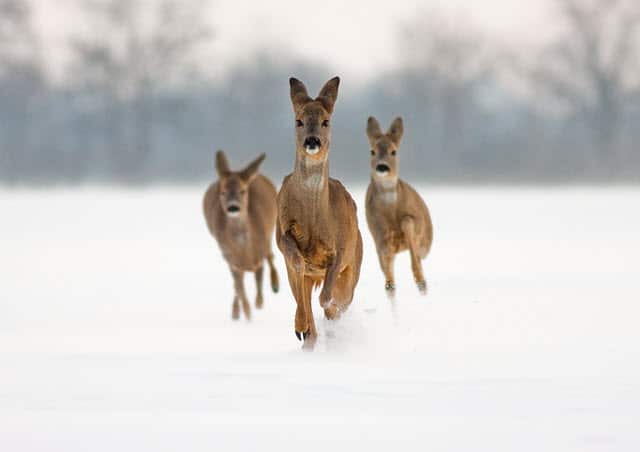
Thus, deer are relatively familiar with human activity and are more acutely aware of human behavior than other animals.
This can be useful since it means some deer are more used to people and will not flee at first sight of one, but it also means they’ve learned that humans are as much of a threat as other predators, if not a greater one.
How to Find Where Deer Sleep in Winter
To increase your chance of finding a deer asleep during the winter, it’s best to know the habits of the specific type of deer you are hunting. It’s also important to know the area where you are hunting so that you can scout out where deer are likely to sleep.
If you know your deer, and you know your land, you’re much more likely to find deer than if you just go out looking for them.

